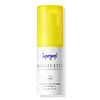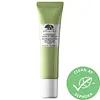What's inside
What's inside
 Key Ingredients
Key Ingredients

 Benefits
Benefits

 Concerns
Concerns

 Ingredients Side-by-side
Ingredients Side-by-side

Zinc Oxide 14.4%
Cosmetic ColorantWater
Skin ConditioningCaprylic/Capric Triglyceride
MaskingGlycerin
HumectantPropanediol
SolventButyloctyl Salicylate
Skin ConditioningGlyceryl Stearate Citrate
EmollientLauroyl Lysine
Skin ConditioningCetyl Esters
EmollientInulin Lauryl Carbamate
Emulsion StabilisingPolyhydroxystearic Acid
EmulsifyingCetearyl Alcohol
EmollientPotassium Cetyl Phosphate
EmulsifyingGriffonia Simplicifolia Seed Extract
Skin ConditioningTitanium Dioxide
Cosmetic ColorantOlive Oil Polyglyceryl-6 Esters
EmollientMica
Cosmetic ColorantTriethoxycaprylylsilane
Microcrystalline Cellulose
AbsorbentGlyceryl Glucoside
HumectantHydroxyacetophenone
AntioxidantPolyurethane-79
Diethylhexyl Syringylidenemalonate
Skin ProtectingSodium Stearoyl Lactylate
Emulsifying1,2-Hexanediol
Skin ConditioningCaprylyl Glycol
EmollientSodium Citrate
BufferingTrisodium Ethylenediamine Disuccinate
Camellia Sinensis Leaf Extract
AntimicrobialLactobacillus Ferment Lysate
Skin ConditioningPunica Granatum Extract
AstringentSodium Stearoyl Glutamate
CleansingXanthan Gum
EmulsifyingCellulose Gum
Emulsion StabilisingIron Oxides
Hedychium Coronarium Root Extract
MaskingLactobacillus Ferment
Skin ConditioningCaffeine
Skin ConditioningLeuconostoc/Radish Root Ferment Filtrate
AntimicrobialTin Oxide
AbrasiveZinc Oxide 14.4%, Water, Caprylic/Capric Triglyceride, Glycerin, Propanediol, Butyloctyl Salicylate, Glyceryl Stearate Citrate, Lauroyl Lysine, Cetyl Esters, Inulin Lauryl Carbamate, Polyhydroxystearic Acid, Cetearyl Alcohol, Potassium Cetyl Phosphate, Griffonia Simplicifolia Seed Extract, Titanium Dioxide, Olive Oil Polyglyceryl-6 Esters, Mica, Triethoxycaprylylsilane, Microcrystalline Cellulose, Glyceryl Glucoside, Hydroxyacetophenone, Polyurethane-79, Diethylhexyl Syringylidenemalonate, Sodium Stearoyl Lactylate, 1,2-Hexanediol, Caprylyl Glycol, Sodium Citrate, Trisodium Ethylenediamine Disuccinate, Camellia Sinensis Leaf Extract, Lactobacillus Ferment Lysate, Punica Granatum Extract, Sodium Stearoyl Glutamate, Xanthan Gum, Cellulose Gum, Iron Oxides, Hedychium Coronarium Root Extract, Lactobacillus Ferment, Caffeine, Leuconostoc/Radish Root Ferment Filtrate, Tin Oxide
Titanium Dioxide 5.7%
Cosmetic ColorantZinc Oxide 3.8%
Cosmetic ColorantIsocetyl Stearoyl Stearate
EmollientButylene Glycol
HumectantC12-15 Alkyl Benzoate
AntimicrobialCetyl Alcohol
EmollientButyrospermum Parkii Butter
Skin ConditioningLaureth-4
EmulsifyingDimethicone
EmollientTrehalose
HumectantPolyethylene
AbrasivePEG-100 Stearate
Cetyl Esters
EmollientCamellia Sinensis Leaf Extract
AntimicrobialSigesbeckia Orientalis Extract
Skin ConditioningVaccinium Macrocarpon Fruit Extract
AstringentVaccinium Angustifolium Fruit Extract
Skin ProtectingSolanum Tuberosum Pulp Extract
SmoothingTuna Extract
Skin ConditioningLycium Chinense Fruit Extract
AntioxidantEriobotrya Japonica Leaf Extract
Skin ConditioningSaccharum Officinarum Extract
MoisturisingBetula Alba Bark Extract
MaskingPassiflora Incarnata Flower Extract
Skin ConditioningLythrum Salicaria Extract
AstringentSaccharomyces Lysate Extract
HumectantPhytosphingosine
Skin ConditioningAminopropyl Ascorbyl Phosphate
AntioxidantLeontopodium Alpinum Extract
Skin ConditioningAlgae Extract
EmollientSodium Hyaluronate
HumectantYeast Extract
Skin ConditioningBoswellia Serrata Extract
Skin ConditioningAstrocaryum Murumuru Seed Butter
EmollientErgothioneine
AntioxidantOryzanol
Skin ConditioningHydroxyethyl Acrylate/Sodium Acryloyldimethyl Taurate Copolymer
Emulsion StabilisingLauric Acid
CleansingGlycerin
HumectantSqualane
EmollientTocopheryl Acetate
AntioxidantIsostearic Acid
CleansingCaprylyl Glycol
EmollientPolyhydroxystearic Acid
EmulsifyingPolysorbate 60
EmulsifyingSodium PCA
HumectantUrea
BufferingSodium Phytate
Aluminum Hydroxide
EmollientTromethamine
BufferingHexylene Glycol
EmulsifyingPolyquaternium-51
Skin ConditioningLecithin
EmollientBHT
AntioxidantPhenoxyethanol
PreservativeMica
Cosmetic ColorantIron Oxides
Titanium Dioxide 5.7%, Zinc Oxide 3.8%, Isocetyl Stearoyl Stearate, Butylene Glycol, C12-15 Alkyl Benzoate, Cetyl Alcohol, Butyrospermum Parkii Butter, Laureth-4, Dimethicone, Trehalose, Polyethylene, PEG-100 Stearate, Cetyl Esters, Camellia Sinensis Leaf Extract, Sigesbeckia Orientalis Extract, Vaccinium Macrocarpon Fruit Extract, Vaccinium Angustifolium Fruit Extract, Solanum Tuberosum Pulp Extract, Tuna Extract, Lycium Chinense Fruit Extract, Eriobotrya Japonica Leaf Extract, Saccharum Officinarum Extract, Betula Alba Bark Extract, Passiflora Incarnata Flower Extract, Lythrum Salicaria Extract, Saccharomyces Lysate Extract, Phytosphingosine, Aminopropyl Ascorbyl Phosphate, Leontopodium Alpinum Extract, Algae Extract, Sodium Hyaluronate, Yeast Extract, Boswellia Serrata Extract, Astrocaryum Murumuru Seed Butter, Ergothioneine, Oryzanol, Hydroxyethyl Acrylate/Sodium Acryloyldimethyl Taurate Copolymer, Lauric Acid, Glycerin, Squalane, Tocopheryl Acetate, Isostearic Acid, Caprylyl Glycol, Polyhydroxystearic Acid, Polysorbate 60, Sodium PCA, Urea, Sodium Phytate, Aluminum Hydroxide, Tromethamine, Hexylene Glycol, Polyquaternium-51, Lecithin, BHT, Phenoxyethanol, Mica, Iron Oxides
Ingredients Explained
These ingredients are found in both products.
Ingredients higher up in an ingredient list are typically present in a larger amount.
Camellia Sinensis Leaf Extract is derived from the leaves of the tea plant. Black tea, green tea, and oolong tea are all harvested from this plant.
This ingredient has many skin benefits:
This ingredient contains polyphenols, a strong antioxidant. Antioxidants help fight off molecules that damage skin cells.
On top of that, the antioxidants in green tea neutralize free-radicals from the sun. This gives the skin some extra UV protection, but should not replace sunscreen.
Many components of tea have anti-inflammatory properties.
Polyphenols and L-theanine help soothe the skin and reduce irritation. The caffeine in Camellia Sinensis Leaf Extract helps calm inflamed blood vessels.
Other compounds found in tea include: Vitamin Bs, linoleic acid, magnesium, calcium, iron, and zinc.
Research has shown both drinking Camellia Sinensis Leaf Tea and applying it to the skin can help boost skin elasticity and hydration. Studies also show using tea extract may reduce sebum, or oil, production.
Learn more about Camellia Sinensis Leaf ExtractCaprylyl Glycol is a humectant and emollient, meaning it attracts and preserves moisture.
It is a common ingredient in many products, especially those designed to hydrate skin. The primary benefits are retaining moisture, skin softening, and promoting a healthy skin barrier.
Though Caprylyl Glycol is an alcohol derived from fatty acids, it is not the kind that can dry out skin.
This ingredient is also used as a preservative to extend the life of products. It has slight antimicrobial properties.
Learn more about Caprylyl GlycolCetyl Esters is a synthetic wax made up of mostly fatty acids and fatty alcohols. It is strcturally similar to wax taken from whales.
As an emollient, it creates a thin barrier on the skin. This barrier prevents moisture from escaping.
This ingredient may not be fungal-acne safe.
Learn more about Cetyl EstersGlycerin is already naturally found in your skin. It helps moisturize and protect your skin.
A study from 2016 found glycerin to be more effective as a humectant than AHAs and hyaluronic acid.
As a humectant, it helps the skin stay hydrated by pulling moisture to your skin. The low molecular weight of glycerin allows it to pull moisture into the deeper layers of your skin.
Hydrated skin improves your skin barrier; Your skin barrier helps protect against irritants and bacteria.
Glycerin has also been found to have antimicrobial and antiviral properties. Due to these properties, glycerin is often used in wound and burn treatments.
In cosmetics, glycerin is usually derived from plants such as soybean or palm. However, it can also be sourced from animals, such as tallow or animal fat.
This ingredient is organic, colorless, odorless, and non-toxic.
Glycerin is the name for this ingredient in American English. British English uses Glycerol/Glycerine.
Learn more about GlycerinMica is a naturally occurring mineral used to add shimmer and color in cosmetics. It can also help improve the texture of a product or give it an opaque, white/silver color.
Serecite is the name for very fine but ragged grains of mica.
This ingredient is often coated with metal oxides like titanium dioxide. Trace amounts of heavy metals may be found in mica, but these metals are not harmful in our personal products.
Mica has been used since prehistoric times throughout the world. Ancient Egyptian, Indian, Greek, Roman, Aztec, and Chinese civilizations have used mica.
Learn more about MicaPolyhydroxystearic Acid is a soft wax made from castor oil.
It is is a texture thickener, emulsifier, and film-former. Emulsifiers prevent ingredients from separating, such as oils and waters.
Polyhydroxystearic Acid may not be fungal acne safe.
Learn more about Polyhydroxystearic AcidTitanium dioxide is a mineral UV filter widely used in sunscreens and cosmetics.
It is one of only two UV filters officially classified as “mineral” by regulatory agencies, the other being zinc oxide.
Titanium dioxide provides broad-spectrum protection mostly in the UVB and UVAII range, with some protection in the UVAI range.
While its UVA protection isn’t as strong as zinc oxide’s, the difference is minor.
A common myth is that mineral UV filters reflect UV light. However, modern research shows titanium dioxide absorbs UV radiation like chemical filters (~95% absorption & 5% reflection).
Thanks to its non-irritating nature, titanium dioxide is suitable for sensitive, acne-prone, or redness-prone skin. It is unlikely to cause "eye sting" like other sunscreen ingredients.
A major drawback of this ingredient is its white cast and thick texture. This is why mineral sunscreens often leave a white cast and are less cosmetically elegant than chemical/hybrid sunscreens.
To improve white cast and spreadability, micronized or nano-sized titanium dioxide is often used.
There are ongoing concerns surrounding nano-titanium oxide's impact on marine ecosystems.
There is no conclusive evidence that any form of titanium oxide (or any other sunscreen ingredients) will cause harm to marine ecosystems or coral reefs. The science is still developing but many consumers are keeping a close eye on this issue.
Please note, many destinations have reef-safety sunscreen rules. For instance, the U.S. Virgin Islands advises all visitors to use non-nano mineral sunscreens.
Nano mineral sunscreens once raised safety concerns about absorption into skin.
Extensive research has shown that they do not penetrate healthy or damaged skin; they remain safely on the surface and the top layer of dead skin (stratum corneum).
You'll likely find titanium dioxide bundled with alumina, silica, or dimethicone. These ingredients help make titanium dioxide highly photostable; this prevents it from interacting with other formula components under UV light.
Learn more about Titanium DioxideZinc Oxide is a mineral broad-spectrum UV filter; it is the broadest UVA and UVB reflector approved by the FDA. It also has skin protectant and skin soothing properties.
Zinc oxide is one of the most effective broad-spectrum UV filters. It protects against UVB, UVAII, and UVAI. In comparison to its counterpart titanium dioxide, zinc oxide provides uniform and extended UVA protection.
Another great benefit? This ingredient is highly photostable so it won't degrade easily under sunlight.
A common myth is that mineral UV filters are widely believed to primarily reflect UV light.
However, modern research shows titanium dioxide absorbs UV radiation like chemical filters (~95% absorption & 5% reflection).
Zinc oxide has great skin soothing properties so you'll likely find this in sunscreens formulated for sensitive skin or babies/children. It is unlikely to cause "eye sting" like other sunscreen ingredients.
Regulatory agencies consider zinc oxide to be non-toxic and safe. It has also been shown to not penetrate the skin.
Unfortunately, this ingredient does leave a visible white cast. This is why mineral sunscreens are often less cosmetically elegant than chemical or hybrid ones.
In cosmetics, zinc oxide can be found in both non-nano and nano-sized forms. The nano version is used to reduce white cast and improve the texture of sunscreen formulas.
There are ongoing concerns surrounding nano-zinc oxide's impact on marine ecosystems and whether it can be absorbed into skin.
Regarding marine ecosystems and coral reefs, there is no conclusive evidence that any form of zinc oxide (or any other sunscreen ingredients) will cause harm. The science is still developing but many consumers are keeping a close eye on this issue.
Please note, many destinations have reef-safety sunscreen rules. For instance, the U.S. Virgin Islands advises all visitors to use non-nano mineral sunscreens.
There has also been some stir about whether micronized or nano zinc oxide has potential photoxicity and absorption through the skin/lungs.
An in-vitro (done in a test tube or petri dish) study demonstrated micronized zinc oxide to have potential phototoxicity. There's no need to fret; the EU Commission's Scientific Committee on Consumer Safety has stated, "The relevance of these findings needs to be clarified by appropriate investigations in vivo." Or in other words, further studies done on living organisms are needed to prove this.
Current research shows zinc oxide nanoparticles do not penetrate intact or sunburned skin. They either remain on the surface or in the outermost layer of dead skin (stratum corneum).
Zinc oxide is one of only two classified mineral UV filters with titanium dioxide being the other one.
Fun fact: Zinc has been used throughout history as an ingredient in paint and medicine. An Indian text from 500BC is believed to list zinc oxide as a salve for open wound. The Ancient Greek physician Dioscorides has also mentioned the use of zinc as an ointment in 1AD.
Learn more about Zinc OxideThis ingredient is a combination of red, black, and yellow iron oxide pigments. This combination of colors is usually found in foundation, because it results in a "skin" color.